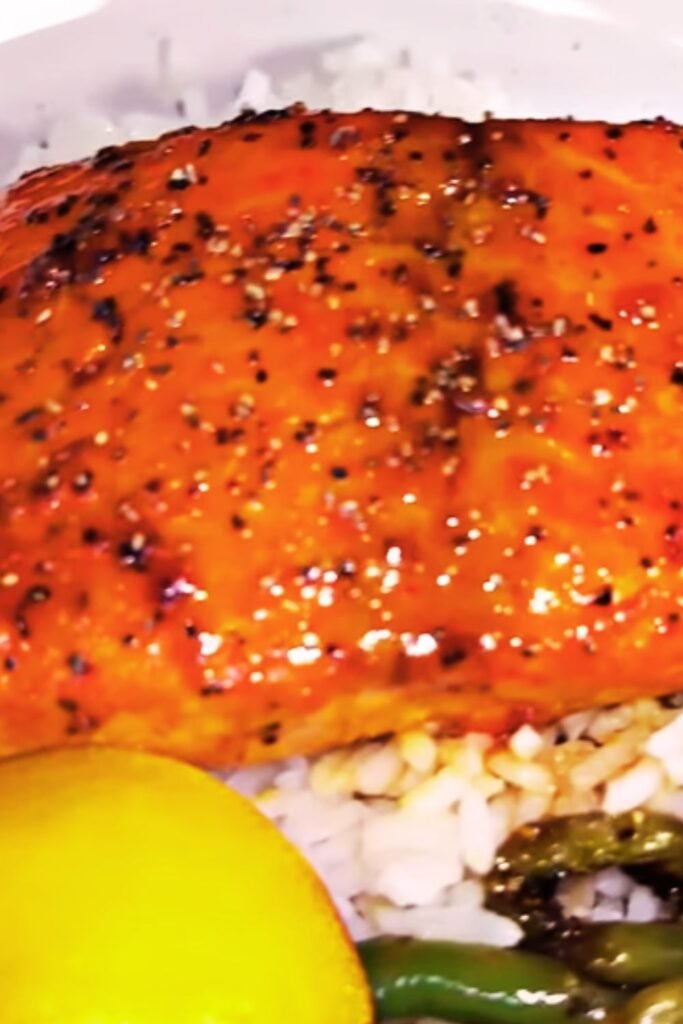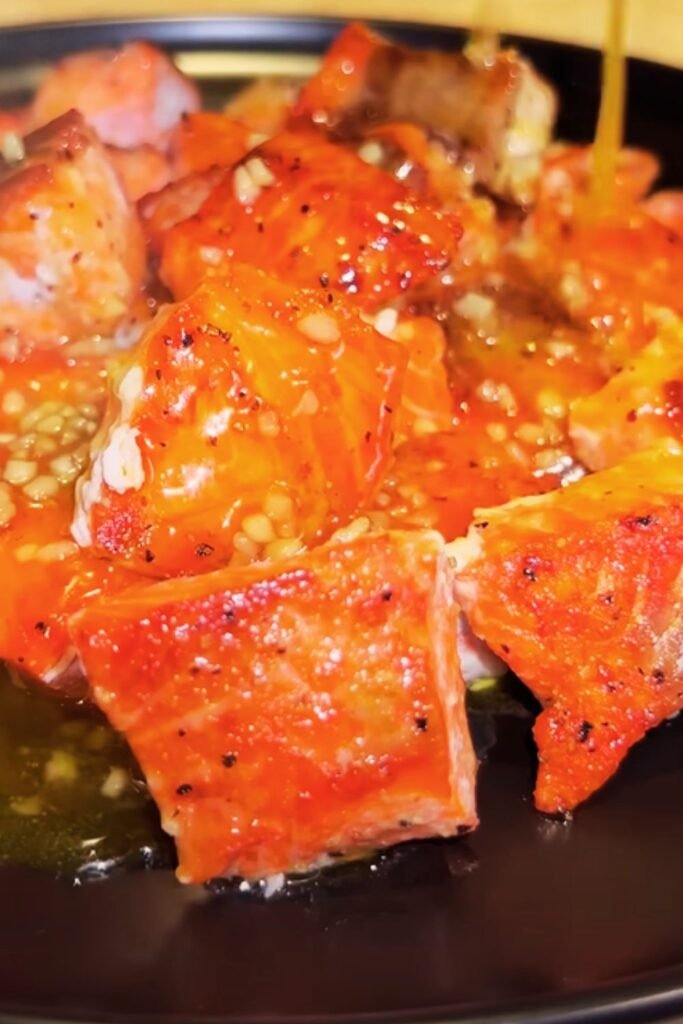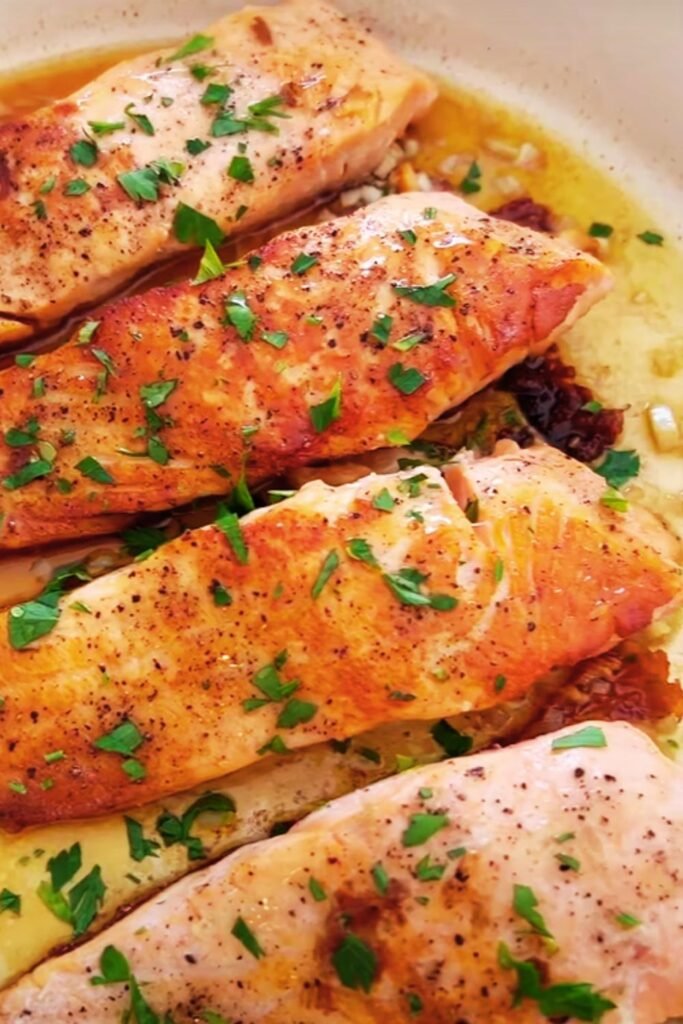I’ve been perfecting this honey garlic salmon recipe for years, and I can confidently say it’s become my go-to weeknight dinner when I want something that feels fancy but comes together in under 30 minutes. The combination of sweet honey, savory garlic, and perfectly flaky salmon creates a dish that never fails to impress both my family and dinner guests.
What makes this recipe truly special isn’t just the incredible flavor profile – it’s the simplicity. I’ve streamlined the process so you can achieve restaurant-quality results with ingredients you likely already have in your pantry. The glaze caramelizes beautifully, creating a glossy coating that locks in the salmon’s natural moisture while adding layers of complex flavor.
Why This Recipe Works
After countless attempts at perfecting honey garlic salmon, I’ve discovered the key elements that make this version superior to others. The secret lies in the timing and technique. I start by searing the salmon skin-side up to develop a beautiful crust, then flip it carefully to finish cooking. Meanwhile, the honey garlic glaze reduces to the perfect consistency – thick enough to coat the fish but not so thick that it becomes sticky or overpowering.
The balance of flavors is crucial here. I use a specific ratio of honey to soy sauce that creates depth without overwhelming the delicate salmon. Fresh garlic provides aromatic punch, while a touch of ginger adds warmth and complexity. The result is a glaze that complements rather than masks the fish’s natural flavor.
Essential Ingredients Breakdown
Let me walk you through each component and why it matters for achieving the perfect honey garlic salmon:
Fresh Salmon Fillets : I always recommend skin-on salmon fillets, preferably Atlantic or Pacific varieties. The skin helps hold the fish together during cooking and becomes deliciously crispy when seared properly. Look for fillets that are about 6 ounces each and 1-inch thick for even cooking.
Raw Honey : The quality of honey makes a noticeable difference in this recipe. I prefer raw, unprocessed honey because it has more complex flavors and better caramelization properties. Wildflower or clover honey work beautifully, but avoid anything too strongly flavored that might compete with the salmon.
Fresh Garlic : Fresh garlic is non-negotiable here. I use about 4-5 large cloves, minced finely. The garlic should be aromatic and firm – avoid any cloves that are sprouting or have brown spots, as these can add bitter notes to your glaze.
Low-Sodium Soy Sauce : This provides the umami depth that makes the glaze so addictive. I specifically use low-sodium soy sauce because it gives me better control over the saltiness of the final dish. Regular soy sauce can easily overpower the other flavors.
Fresh Ginger : Just a small amount of freshly grated ginger adds warmth and helps balance the sweetness of the honey. I use about a teaspoon of finely grated fresh ginger – the kind you’d find in the produce section, not the dried powder.
Rice Wine Vinegar : This adds a subtle acidity that brightens the entire dish and helps balance the rich, sweet flavors. Apple cider vinegar can work as a substitute, but rice wine vinegar is milder and more complementary to the Asian-inspired flavor profile.

The Perfect Cooking Method
My technique for cooking honey garlic salmon has evolved through trial and error, and I’ve found that this method produces consistently excellent results:
I start by patting the salmon fillets completely dry with paper towels. This step is crucial for achieving a good sear – any excess moisture will cause the fish to steam rather than sear, preventing that beautiful golden crust from forming. I then season both sides generously with salt and freshly ground black pepper.
The pan selection matters more than you might think. I use a heavy-bottomed stainless steel or cast-iron skillet that retains heat well. Non-stick pans work but don’t develop the same depth of flavor through the fond (those delicious browned bits that form on the bottom of the pan).
I heat the pan over medium-high heat and add a thin layer of neutral oil with a high smoke point – avocado oil or grapeseed oil work perfectly. When the oil shimmers and moves freely around the pan, I know it’s ready for the salmon.
The first sear is critical. I place the salmon skin-side up and resist the urge to move it. The fish will naturally release from the pan when it’s ready to flip – usually after 4-5 minutes. I listen for the sizzling sound, which should be consistent but not aggressive. If it’s too quiet, the heat is too low; if it’s spattering violently, I reduce the heat slightly.
Creating the Perfect Glaze
While the salmon sears, I prepare the honey garlic glaze. This timing is important because the glaze comes together quickly, and I want it ready when the salmon is nearly done.
In a small bowl, I whisk together the honey, soy sauce, minced garlic, grated ginger, and rice wine vinegar. The mixture should be smooth and well combined. I taste it at this stage and adjust if needed – sometimes I add a pinch more ginger if I want extra warmth, or a splash more vinegar if it tastes too sweet.
When I flip the salmon (after that initial 4-5 minute sear), I immediately pour the glaze mixture into the pan around the fish. The glaze will bubble and start to caramelize almost immediately. This is where the magic happens – the sugars in the honey begin to break down and concentrate, while the garlic becomes fragrant and mellows.
I use a spoon to baste the salmon with the glaze as it reduces. This not only flavors the fish but also creates that beautiful, glossy coating that makes the dish look so professional. The entire glazing process takes about 3-4 minutes, during which time the salmon finishes cooking to perfection.
Detailed Recipe Instructions
Here’s my complete method for making the perfect honey garlic salmon:
Preparation Phase:
- Remove salmon from refrigerator 15 minutes before cooking to bring to room temperature
- Pat fillets completely dry with paper towels
- Season both sides generously with salt and pepper
- Mince garlic finely and grate ginger
- Whisk together glaze ingredients in a small bowl
Cooking Phase:
- Heat heavy-bottomed pan over medium-high heat
- Add thin layer of neutral oil (avocado or grapeseed)
- When oil shimmers, carefully place salmon skin-side up
- Sear undisturbed for 4-5 minutes until golden crust forms
- Flip salmon carefully using a thin spatula
- Immediately pour glaze around (not over) the fish
- Reduce heat to medium and let glaze bubble and caramelize
- Baste salmon with glaze using a spoon for 3-4 minutes
- Remove from heat when salmon reaches 145°F internal temperature

Nutritional Information and Health Benefits
This honey garlic salmon recipe isn’t just delicious – it’s also incredibly nutritious. Salmon is one of the best sources of omega-3 fatty acids, which support heart health, brain function, and reduce inflammation throughout the body. A single serving provides approximately 22 grams of high-quality protein, making it an excellent choice for muscle maintenance and repair.
The honey in this recipe, while adding sweetness, also provides antioxidants and has antimicrobial properties. I use just enough to create the glaze without making the dish overly sweet or high in added sugars. Each serving contains roughly 4 grams of added sugar from the honey, which is reasonable for a complete meal.
Garlic offers numerous health benefits, including immune system support and potential cardiovascular benefits. The fresh ginger adds anti-inflammatory compounds that may help with digestion and overall wellness.
Recipe Variations and Adaptations
Over the years, I’ve experimented with numerous variations of this basic honey garlic salmon recipe. Here are some of my favorite adaptations:
Spicy Honey Garlic Version: I add a teaspoon of sriracha or red pepper flakes to the glaze for those who enjoy heat. The spice complements the sweetness beautifully without overwhelming the dish.
Citrus Enhanced: Sometimes I add the zest of one lemon or lime to the glaze, along with a tablespoon of fresh citrus juice. This brightens the entire dish and adds a fresh, summery quality.
Herb-Crusted Variation: Before glazing, I sometimes press chopped fresh herbs (dill, parsley, or chives) onto the top of the salmon fillets. The herbs add color and freshness that pairs wonderfully with the sweet glaze.
Asian-Inspired Twist: I occasionally add a tablespoon of miso paste to the glaze for deeper umami flavor, or substitute maple syrup for honey for a different sweetness profile.
Serving Suggestions and Pairings
I’ve served this honey garlic salmon countless times, and I’ve discovered the perfect accompaniments that complement without competing with the star of the show.
My go-to side dish is jasmine rice or quinoa, which absorbs the extra glaze beautifully. I often prepare the rice with a little coconut milk for added richness. Steamed vegetables work wonderfully – I particularly love broccoli, asparagus, or baby bok choy. The slight bitterness of these vegetables balances the sweetness of the glaze perfectly.
For a more substantial meal, I serve the salmon over a bed of mixed greens with a light vinaigrette. The fresh, crisp lettuce provides a nice textural contrast to the rich, glazed fish. Roasted vegetables like Brussels sprouts or sweet potatoes also pair beautifully with this dish.
Common Mistakes and How to Avoid Them
Through years of making this recipe and teaching it to friends, I’ve identified the most common mistakes that can sabotage your results:
Overcooking the Salmon: This is the biggest mistake I see. Salmon should be cooked to 145°F internal temperature, but it continues cooking even after removing from heat. I recommend checking the temperature when the thickest part of the fillet reaches 140°F, then removing it from heat to let carryover cooking finish the job.
Using Cold Salmon: Cooking salmon straight from the refrigerator results in uneven cooking. I always let my fillets come to room temperature for about 15 minutes before cooking. This ensures even cooking throughout.
Not Drying the Fish: Moisture is the enemy of a good sear. I always pat the salmon completely dry with paper towels before seasoning. Any surface moisture will cause steaming instead of searing.
Burning the Glaze: The sugars in honey can burn quickly. If your glaze starts to smoke or turns dark brown too quickly, reduce the heat immediately. The goal is caramelization, not burning.

Storage and Reheating Tips
Leftover honey garlic salmon stores well in the refrigerator for up to three days. I place it in an airtight container and refrigerate it as soon as it cools to room temperature. When reheating, I prefer using the oven at 275°F for about 10-12 minutes rather than the microwave, which can make the fish rubbery.
For meal prep, I sometimes cook the salmon and store it separately from the glaze. This prevents the fish from becoming too saturated with the sweet sauce. I reheat the salmon gently and warm the glaze separately, then combine them just before serving.
Troubleshooting Guide
Problem: Salmon sticks to the pan Solution: Ensure the pan is properly heated and the salmon is completely dry before adding to the pan. Don’t move the fish until it naturally releases.
Problem: Glaze is too thick Solution: Add a tablespoon of water or low-sodium chicken broth to thin it out. Whisk over low heat until desired consistency is reached.
Problem: Glaze is too thin Solution: Continue cooking the glaze for an additional 1-2 minutes to reduce and concentrate the flavors.
Problem: Salmon is overcooked Solution: Next time, check the internal temperature earlier and remember that carryover cooking will continue after removing from heat.
Seasonal Adaptations
I love adapting this recipe based on what’s available seasonally. In spring, I might add fresh herbs like dill or chives. Summer calls for a squeeze of fresh lemon and maybe some diced cucumber as a side. Fall inspired me to add a touch of apple cider vinegar instead of rice wine vinegar, and winter versions might include a pinch of warming spices like cinnamon or five-spice powder.
Complete Recipe Summary
| Component | Amount | Notes |
|---|---|---|
| Salmon fillets | 4 pieces (6 oz each) | Skin-on, 1-inch thick |
| Honey | 1/4 cup | Raw, unprocessed preferred |
| Soy sauce | 3 tablespoons | Low-sodium |
| Fresh garlic | 4 large cloves | Minced finely |
| Fresh ginger | 1 teaspoon | Grated |
| Rice wine vinegar | 1 tablespoon | Can substitute apple cider vinegar |
| Salt | 1 teaspoon | For seasoning |
| Black pepper | 1/2 teaspoon | Freshly ground |
| Oil | 2 tablespoons | Neutral, high smoke point |
Nutritional Information Per Serving
| Nutrient | Amount | % Daily Value |
|---|---|---|
| Calories | 342 | 17% |
| Protein | 35g | 70% |
| Total Fat | 18g | 28% |
| Saturated Fat | 4g | 20% |
| Omega-3 Fatty Acids | 1.8g | N/A |
| Carbohydrates | 12g | 4% |
| Sugars | 11g | N/A |
| Sodium | 580mg | 24% |
| Potassium | 628mg | 18% |
Cooking Time Breakdown
| Stage | Time | Temperature |
|---|---|---|
| Prep time | 10 minutes | Room temp |
| First sear | 4-5 minutes | Medium-high heat |
| Flip and glaze | 3-4 minutes | Medium heat |
| Rest time | 2 minutes | Off heat |
| Total time | 20 minutes | N/A |
Questions and Answers
Q: Can I use frozen salmon for this recipe? A: I don’t recommend using frozen salmon directly. If you must use frozen salmon, thaw it completely in the refrigerator overnight, then pat it thoroughly dry before cooking. Frozen salmon tends to release more moisture during cooking, which can prevent proper searing.
Q: What’s the best way to tell when salmon is done? A: The most reliable method is using an instant-read thermometer. The internal temperature should reach 145°F. Visually, the salmon should be opaque throughout and flake easily with a fork. The center should still be slightly translucent pink, not completely opaque.
Q: Can I make this recipe without skin-on salmon? A: Absolutely! Skinless salmon fillets work perfectly fine. You might need to be a bit more gentle when flipping the fish since the skin helps hold it together, but the flavor and cooking method remain the same.
Q: How long can I store the honey garlic glaze? A: The glaze can be prepared up to 3 days in advance and stored in the refrigerator. I like to bring it to room temperature before using, and sometimes I need to whisk it again if the ingredients have separated.
Q: What should I do if my glaze burns? A: If the glaze starts to burn, immediately remove the pan from heat and transfer the salmon to a plate. You can start over with a fresh batch of glaze in a clean pan, or if it’s only slightly burnt, you can strain out the burnt bits and thin the glaze with a little water.
Q: Can I double this recipe for a larger crowd? A: Yes, but you’ll need to use a larger pan or cook in batches. Don’t overcrowd the pan, as this will cause the salmon to steam rather than sear. If cooking in batches, keep the first batch warm in a 200°F oven while preparing the second batch.
Q: Is there a substitute for soy sauce? A: You can use tamari for a gluten-free option, or coconut aminos for a soy-free alternative. Both will give you that umami depth, though the flavor will be slightly different. Start with the same amount and adjust to taste.
Q: Can I prepare this recipe on the grill? A: Yes! I’ve successfully made this on the grill using a cast-iron skillet or grill pan. The key is maintaining consistent heat and having all your ingredients ready before you start, since you’ll have less control over the heat than on a stovetop.
Q: What wine pairs well with honey garlic salmon? A: I find that a crisp white wine like Sauvignon Blanc or Pinot Grigio complements the sweet and savory flavors beautifully. The acidity in these wines balances the richness of the salmon and the sweetness of the honey.
Q: Can I use this glaze on other types of fish? A: Absolutely! This glaze works wonderfully on other firm fish like cod, halibut, or mahi-mahi. You may need to adjust the cooking time depending on the thickness of the fish, but the glaze technique remains the same.
This honey garlic salmon recipe has become one of my most requested dishes, and I hope it becomes a favorite in your kitchen too. The combination of simple ingredients, straightforward technique, and impressive results makes it perfect for both weeknight dinners and special occasions. The key is not to overthink it – let the quality of your ingredients shine through, and don’t be afraid to taste and adjust the glaze to your preferences.